Church Rock uranium mill spill
| United Nuclear Corp. Church Rock | |
|---|---|
| Superfund site | |
|
The United Nuclear Corporation Site near Church Rock in McKinley County, New Mexico | |
| Geography | |
| City | Gallup, New Mexico |
| County | McKinley |
| State | New Mexico |
| Coordinates | 35°39′03″N 108°30′23″W / 35.65083°N 108.50639°WCoordinates: 35°39′03″N 108°30′23″W / 35.65083°N 108.50639°W |
 United Nuclear Corp. Church Rock 2,133 m (6,998 ft) | |
| Information | |
| CERCLIS ID | NMD030443303 |
| Contaminants | Metals, radionuclides |
| Responsible parties | United Nuclear, Inc. |
| Progress | |
| Proposed | 12/30/1982 |
| Listed | 09/08/1983 |
| Construction completed | 09/29/1998 |
| List of Superfund sites | |
The Church Rock uranium mill spill occurred in the US state of New Mexico on July 16, 1979, when United Nuclear Corporation's Church Rock uranium mill tailings disposal pond breached its dam.[1][2] Over 1,000 tons of solid radioactive mill waste and 93 million gallons of acidic, radioactive tailings solution flowed into the Puerco River, and contaminants traveled 80 miles (130 km) downstream to Navajo County, Arizona and onto the Navajo Nation.[2] The mill was located on privately owned land approximately 17 miles north of Gallup, New Mexico, and bordered to the north and southwest by Navajo Nation Tribal Trust lands.[3] Local residents, who were mostly Navajos, used the Puerco River for irrigation and livestock and were not immediately aware of the toxic danger.[2]
The accident is frequently described as having released more radioactivity than the Three Mile Island accident that occurred four months earlier and was the largest release of radioactive material in U.S. history.[2][4][5][6] The spill contaminated groundwater and rendered the Puerco unusable by local residents. The governor of New Mexico refused the Navajo Nation's request that the site be declared a federal disaster area, limiting aid to affected residents.[7] The event received less media coverage than that of Three Mile Island, likely because it occurred in a lightly populated, rural area.[8] Some scholars suggest there were elements of class and racism to the neglect as well, since it affected primarily poor Native Americans.[5]
In 2003 the Churchrock Chapter of the Navajo Nation began the Church Rock Uranium Monitoring Project to assess environmental impacts of abandoned uranium mines; it found significant radiation from both natural and mining sources in the area.[9] The EPA National Priorities List currently includes the Church Rock tailings storage site, where "groundwater migration is not under control."[10]
Dam failure
At around 5:30 am on July 16, 1979, a 20-foot breach formed in the south cell of United Nuclear Corporation's Church Rock uranium mill tailings disposal pond, and 1,100 tons of solid radioactive mill waste and approximately 93 million US gallons (350,000 m3) of acidic, radioactive tailings solution flowed into Pipeline Arroyo, a tributary of the Puerco River.[2][5][11][12] Though the uranium mill only bordered the Navajo Nation, the spilled tailings spilled onto the Navajo Nation as they flowed down the Puerco River.[2]
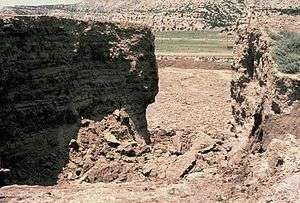
The tailings solution had a pH of 1.2[13] and a gross alpha particle activity of 128 nanocuries (4.7 kBq) per liter, and contained radioactive uranium, thorium, radium, polonium, metals including cadmium, aluminum, magnesium, manganese, molybdenum, nickel, selenium, sodium, vanadium, zinc, iron, lead, and high concentrations of sulfates.[14] The contaminated water from the Church Rock spill traveled 80 miles (130 km) downstream, through Gallup, New Mexico, and reached as far as Navajo County, Arizona. The flood backed up sewers, affected nearby aquifers, and left stagnating, contaminated pools on the riverside.[5][15][16]
Response
At 6:00 am, a United Nuclear Corporation employee noticed the breach and suspended further discharge of tailings solution to the holding pond.[5] By 8:00, a temporary dike had stopped the flow of residual tailings solution.[5]
The Indian Health Service and the Environmental Improvement Division of New Mexico warned local residents over the radio and with signs not to drink from, water livestock at, or enter the Puerco River, but many Navajos in the area didn't speak English or couldn't read and were unaware of the dangers of radiation.[17][18] United Nuclear Corporation employees were dispatched to warn Navajo-speaking residents downstream in accordance with a state contingency plan, but not until a few days after the spill.[4][19] The Navajo Nation asked the governor of New Mexico to request disaster assistance from the US government and have the site declared a disaster area, but he refused, limiting disaster relief assistance to the Navajo Nation.[5]
The New Mexico Environmental Improvement Division said the spill's "short-term and long-term impacts on people and the environment were quite limited."[20] United Nuclear denied claims that the spill caused livestock deaths. The company said in a statement issued by an attorney, "We just don't know of any substance to those claims. Some people aren't going to be satisfied no matter how thoroughly you show it."[20]
Under the "agreement state" legislative framework of the Uranium Mill Tailings Radiation Control Act, the Nuclear Regulatory Commission left New Mexico to handle the dam failure until October 12, 1979, when it was notified that the state would permit the uranium mill to resume operation that week. The NRC then suspended United Nuclear's operating license until it could be determined that the embankment was stable.[21] After fewer than four months of downtime following the dam failure, the mill resumed operations on November 2, 1979. This further contaminated the groundwater and resulted in the mill site's placement on the EPA's National Priorities List in 1983.[5][11] United Nuclear made a $525,000 out-of-court settlement with the Navajo Nation a year after the spill.[22]
In terms of the amount of radioactivity released, the accident was larger in magnitude than the Three Mile Island accident of the same year.[2][4][5] The spill has been called "the largest radioactive accident in U.S. history," but the Nuclear Regulatory Commission has said that this is "an overstatement," and that "there have been a number of other events that have been more significant in terms of radiological impact. The event was more significant from an environmental perspective than from a human one."[1]
Causes
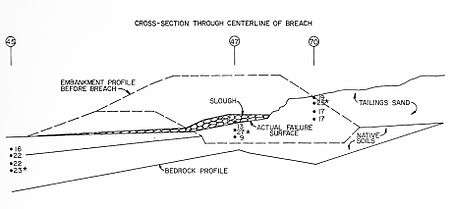
The dam formed the southern wall of one of the mill's three holding ponds, which were used to evaporate tailings solution until the remaining solid waste could be buried.[23] During its operation from 1967 to 1982, the mill produced 3.5 million tons of tailings at the rate of 4,000 tons a day.[3][24][25] The 35-foot-high embankment was constructed on a deposit of collapsible clayey, silty sand a hundred feet deep.[13] United Nuclear used a new design, recommended by the Nuclear Regulatory Commission, that used earth rather than tailings themselves as building material.[17] The holding pond was not lined, in violation of standards in the Uranium Mill Tailings Radiation Control Act of 1978 that required that holding ponds be impermeable.[17] This lack of lining allowed tailings solution to seep into the ground, weakening the foundation of the dam and contaminating the groundwater.[13]
Horizontal and vertical cracks formed along the southern part of the embankment, allowing the acidic tailings solution to penetrate and weaken the embankment.[13] A sand beach was constructed to protect the face of the embankment from the tailings solution, but it was not properly maintained. Prior to the collapse, the level of the tailings solution in the holding pond had risen two feet higher than the dam's designed limit, and the sand beach no longer provided the dam protection.[13][26] The United States Army Corps of Engineers concluded in its report to Governor Bruce King of New Mexico that the principal cause of failure was differential settlement of the foundation beneath the dam wall,[27] and the report commissioned by the Nuclear Regulatory Commission corroborated this conclusion.[13] Critical variations in tailings pond operation practice from approved procedures contributed further to the dam failure.[17][27] United Nuclear's Chief Operating Officer, J. David Hann, blamed the failure of dam on the pointed shape of the bedrock beneath the embankment, which he said acted as a fulcrum and weakened the dam.[4]
Cracks were first noted in the dam wall by independent consultants in December 1977 and were sealed with bentonite and kerosene slurry in February 1978.[13] United Nuclear was notified of the cracking, but, aside from the initial seal, took little or no preventative action.[17] United Nuclear did not make regular inspections of the dam despite strong recommendations by independent consultants that it do so.[17] Further cracking was noted in October 1978. Neither the facility owner nor the State Engineer were formally notified of the episodes of cracking prior to the dam breach, though Arizona representative Morris K. Udall testified before Congress that at least three federal and state agencies had "ample opportunity" to predict that the dam's failure was likely.[27][28] At the same Congressional hearing, the United States Army Corps of Engineers testified that United Nuclear ignored warnings from the Corps that the dam was structurally unsound.[23]
Both New Mexico and Arizona were governed under the Uranium Mill Tailings Radiation Control Act as "agreement states," meaning that they, not the Nuclear Regulatory Commission, were responsible for ensuring compliance with NRC standards.[21] However, the states lacked the equipment and personnel to properly oversee tailings disposal sites statewide, and the ambiguity and drafting errors present in the act left them confused about how much regulatory power they had.[21][29]
Effects
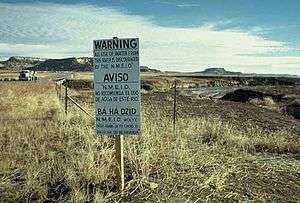
Shortly after the breach, below the dam radioactivity levels of river water were 7000 times that of the allowable level of drinking water.[30] United Nuclear initially claimed that only one curie of radioactivity had been released in the spill, but that figure was later revised upward by the New Mexico Environmental Improvement Division.[31] In all, 46 curies (1.7 TBq) of radioactivity were released.[32]
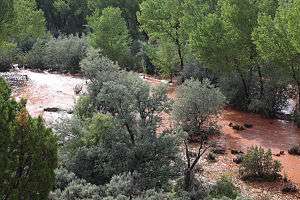
Prior to the spill, local residents used the riverside for recreation and herb-gathering, and children often waded in the Puerco River.[5] Residents who waded in the river after the spill went to the hospital complaining of burning feet and were misdiagnosed with heat stroke.[15] Burns acquired by some of those who came into contact with the contaminated water developed serious infections and required amputations.[22] Herds of sheep and cattle died after drinking the contaminated water, and children played in pools of contaminated water.[23][33] The spill contaminated shallow aquifers near the river that residents drank and used to water livestock.[34] 1,700 people lost access to clean water after the spill.[23] United Nuclear Corporation distributed 600 gallon-jugs of clean water, but the affected area required more than 30,000 gallons of water daily.[2] The three community wells serving Church Rock had already been closed, one because of high radium levels and the other two for high levels of iron and bacteria.[35] The Indian Health Service advised the tribe to repair five shallow wells along the Puerco River and said that the wells "are not expected to show any contamination, if at all, for several years."[2] The Navajo Nation spent $100,000 on clean water,[36] and in 1981, the New Mexico and federal governments stopped providing water, which they had delivered by truck since the spill.[37]
An epidemiological study conducted by the NMEID in 1989 concluded that "the health risk to the public from eating exposed cattle is minimal, unless large amounts of this tissue, especially liver and kidney, are ingested."[38] An Indian Health Service study found significantly higher levels of radionuclides in Church Rock cattle compared to livestock from non-mining areas. The study's authors advised that contamination would not pose a risk as long as residents did not depend on livestock for food over long periods of time, but local Navajos did.[39] A few Navajo children were sent to Los Alamos to be checked for radiation exposure, but no long-term monitoring was undertaken, prompting a local writer to comment that the IHS spent more effort studying livestock than the people affected.[39] No ongoing epidemiological studies have been done at Church Rock.[5][40] Studies have shown since the 1950s that the Navajo have had significantly higher rates for some cancers than the national average, associated with contamination from the uranium mines and the exposure of workers to radiation.[41][42]
Cleanup
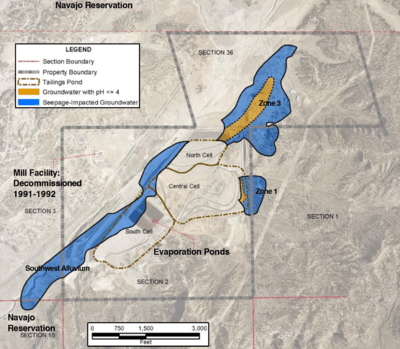
United Nuclear dispatched small crews with shovels and 55-gallon drums to begin cleanup, but expanded the workforce after complaints from local residents and pressure from the state.[26] The crews removed three inches of sediment from the river bed,[43] retrieving about 3,500 barrels (560 m3) of waste materials over the course of three months, but this amount was estimated as only 1% of the solid waste spilled.[5] Groundwater remained contaminated by the spilled tailings solution, and rain transported leftover pollutants downstream into Arizona.[15][26] New Mexico ordered United Nuclear to monitor pools left behind by the spill along the Puerco River, but United Nuclear only measured uranium levels, ignoring the presence of 230Th and 226Ra.[26] The pools contained high levels of sulfuric acid and remained for more than a month after the spill, despite cleanup efforts by the New Mexico Environmental Improvement Division.[31] The NMEID ordered United Nuclear to control tailings seepage from the mill in 1979, and the company implemented a limited seepage collective program in 1981.[24]
The Navajo Nation appealed to the governor to request that the president declare the site a federal disaster area, but he refused, reducing the aid available to local residents.[5] United Nuclear continued operation of the uranium mill until 1982, when it closed because of the declining uranium market.[44]
United Nuclear neutralized the acidity of the tailings with ammonia and lime from 1979 to 1982.[45] In 1983, the site was entered on the National Priorities List of the Environmental Protection Agency's Superfund investigations and cleanup efforts, as radionuclides and chemical constituents were found to be contaminating local groundwater.[11] The EPA conducted a remedial investigation from 1984 to 1987, and in the NRC approved United Nuclear's closure and reclamation plan in 1988.[45]
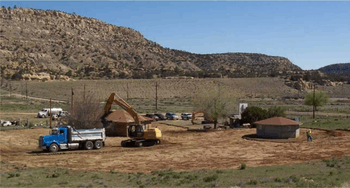
In 1994 the EPA extended its efforts with a study of all known uranium mines on the Navajo Nation.[46][47]
The EPA and United Nuclear removed 175,500 cubic feet (4,970 m3) of radium-contaminated soil surrounding five buildings, some residential, in 2007.[25] The soil was moved to an off-site disposal facility.
In 2003 the Churchrock Chapter of the Navajo Nation began the Church Rock Uranium Monitoring Project to assess environmental impacts of abandoned uranium mines, and build capacity to conduct community-based research with policy implications.[9] Its May 2007 report found significant radiation remaining in the area, from both natural and mining sources.[9]
In 2008, the US Congress authorized a five-year plan for cleanup of contaminated uranium sites on the Navajo reservation.[48] The non-profit Groundswell Educational Films is hosting online videos of the cleanup effort.
See also
- Uranium mining and the Navajo people
- The Return of Navajo Boy
- The Navajo People and Uranium Mining
- Sequoyah Fuels Corporation
References
- 1 2 "Navajos mark 20th anniversary of Church Rock spill", The Daily Courier, Prescott, Arizona, July 18, 1999
- 1 2 3 4 5 6 7 8 9 10 11 Pasternak, Judy (2010). Yellow Dirt: A Poisoned Land and a People Betrayed. Free Press. p. 149. ISBN 1416594825.
- 1 2 3 United Nuclear Corporation (McKinley County) (PDF), EPA, November 21, 2012
- 1 2 3 4 US Congress, House Committee on Interior and Insular Affairs, Subcommittee on Energy and the Environment. Mill Tailings Dam Break at Church Rock, New Mexico, 96th Cong, 1st Sess (October 22, 1979):19–24.
- 1 2 3 4 5 6 7 8 9 10 11 12 13 Brugge, D.; DeLemos, J.L.; Bui, C. (2007), "The Sequoyah Corporation Fuels Release and the Church Rock Spill: Unpublicized Nuclear Releases in American Indian Communities", American Journal of Public Health, 97 (9): 1595–600, doi:10.2105/ajph.2006.103044, PMC 1963288
 , PMID 17666688
, PMID 17666688 - ↑ Quinones, Manuel (December 13, 2011), "As Cold War abuses linger, Navajo Nation faces new mining push", E&E News, retrieved December 28, 2012
- ↑ Pasternak 2010, p. 150.
- ↑ Dingmann, Tracy (July 16, 2009), "New attention to Church Rock uranium spill comes 30 years later", The New Mexico Independent
- 1 2 3 Shuey, Chris; et al. (May 2007), Report of the Church Rock Uranium Monitoring Project 2003-2007, Churchrock Chapter, Navajo Nation, Southwest Research and Information Center and Navajo Education and Scholarship Foundation (PDF), Window Rock, Navajo Nation (Arizona), USA
- ↑ "EPA Superfund Program: UNITED NUCLEAR CORP., CHURCH ROCK, NM". EPA. Retrieved 2016-04-26.
- 1 2 3 Second Five-Year Review Report for the United Nuclear Corporation. Ground Water Operable Unit (PDF), EPA, September 2003, archived from the original (PDF) on 2011-05-31
- ↑ Church Rock tailings spill, The Energy Library, retrieved December 9, 2012
- 1 2 3 4 5 6 7 Nelson, John D.; Kane, Joseph D. (1980).
 The Failure of the Church Rock Tailings Dam. Nuclear Regulatory Commission. Wikisource.
The Failure of the Church Rock Tailings Dam. Nuclear Regulatory Commission. Wikisource. - ↑ Rangel, Valerie (2010). "Church Rock Tailings Spill: July 16, 1979". New Mexico Office of the State Historian. Retrieved December 9, 2012.
- 1 2 3 Giusti, Brendan (July 16, 2009), "Radiation Spill in Church Rock Still Haunts 30 Years Later", The Daily Times, Farmington, New Mexico
- ↑ Szasz, Ferenc Morton (2006). 'Larger Than Life: New Mexico in the Twentieth Century. UNM Press. pp. 82–83. ISBN 0-8263-3883-6.
- 1 2 3 4 5 6 Young, Lise (1981), "What Price Progress? Uranium Production on Indian Lands in the San Juan Basin", American Indian Law Review, 9 (1): 1–50, doi:10.2307/20068184, JSTOR 20068184
- ↑ Brugge, Doug; Benally, Timothy; Yazzie-Lewis, Esther, eds. (2006). The Navajo People and Uranium Mining. University of New Mexico. ISBN 978-0826337795.
- ↑ Kathie Saltzstein, "Navajos Ask $12.5 Million in UNC Suits," Gallup Independent, August 14, 1980
- 1 2 "Uranium Spill Still Worries Navajos", The New York Times, July 21, 1983, retrieved December 9, 2012
- 1 2 3 Grammer, Elisa J. (1981), "The Uranium Mill Tailings Radiation Control Act of 1978 and NRC's Agreement State Program", Natural Resources Lawyer, 13 (3): 469–522, JSTOR 40922651
- 1 2 Kuletz, Valerie (1998). The Tainted Desert. New York: Routledge. p. 27.
- 1 2 3 4 Mantonya, Kurt T. (January 1, 1999), Contamination Nation, University of Nebraska-Lincoln, p. 96
- 1 2 Administrative Order in the matter of United Nuclear Corporation (PDF), EPA, June 29, 1989
- 1 2 Engineering Evaluation/Cost Analysis: Northeast Church Rock (NECR) Mine Site, Gallup, New Mexico, San Francisco: EPA Region 9, May 30, 2009, p. 6
- 1 2 3 4 Wasserman, Harry and Norman Solomon, Killing Our Own: The Disaster of America's Experience with Atomic Radiation, New York: Dell Publishing Co, 1980.
- 1 2 3 Roth, Colonel Bernard J (9 October 1979). Review Comments and Recommendations to Geotechnical Investigational Reports - Church Rock Tailings Dam. Albuquerque, New Mexico: Army Corps of Engineers.
- ↑ Ward, Sinclair (October 23, 1979), "Uranium Spill Described as Preventable", The Washington Post, p. A5, retrieved December 9, 2012
- ↑ Robinson, Paul; Hector, Alice; Luis, Judy; Benavides, David; Hancock, Don (1979), "Uranium Mining and Milling: A Primer" (PDF), The Workbook, Albuquerque, New Mexico: Southwest Research & Information Center, 4 (6-7), retrieved December 9, 2012
- ↑ Bruce E. Johansen "The High Cost of Uranium in Navajoland", Akwesasne Notes New Series, Spring - April May June - 1997, Volume 2 #2, pp. 10-12.
- 1 2 Robertson, Bill (October 4, 1979), "Pediatrician says spill underplayed" (PDF), New Mexico Daily Lobo
- ↑ "Comparison of the Three Mile Island, Chernobyl, Sequoyah Fuels Corporation, and Church Rock Releases," American Journal of Public Health, 2007, 97(9) pp. 1595-1600.
- ↑ Brown, Jovana J.; Lambert, Lori (2010), Blowing in the Wind: The Navajo Nation and Uranium, The Evergreen State College
- ↑ Technical Report on Technologically Enhanced Naturally Occurring Radioactive Materials from Uranium Mining Volume 2: Investigation of Potential Health, Geographic, And Environmental Issues of Abandoned Uranium Mines (PDF), Washington, DC: EPA, Office of Radiation and Indoor Air Radiation Protection Division, April 2008, pp. Appendix IV, p. 7
- ↑ Pasternak 2010, p. 149-150.
- ↑ Nelkin, Dorothy (1981), "Native Americans and Nuclear Power", Science, Technology & Human Values, 6 (2): 2–13, doi:10.1177/016224398100600201, JSTOR 689554
- ↑ Chris Shuey, MPH "The Puerco River: Where Did the Water Go?", Southwest Research and Information Center, 1986
- ↑ Lapham, SC, JB Millard, and JM Samet. "Health implications of radionuclide levels in cattle raised near U mining and milling facilities in Ambrosia Lake, New Mexico. Health Physics Journal, 1989, 56(3) pp. 327-40.
- 1 2 Pasternak 2010, p. 151.
- ↑ Gunter, Linda (September 2009), "Remembering the Forgotten Nuclear Accident", Z Magazine, pp. 6–7
- ↑ Chris Shuey, MPH Uranium Exposure and Public Health in New Mexico and the Navajo Nation: A Literature Summary Southwest Research and Information Center, 02.27.07, rev.10.14.08
- ↑ Pinderhughes, Raquel (1996), "The Impact of Race on Environmental Quality: An Empirical and Theoretical Discussion", Sociological Perspectives, 39 (2): 231–48, doi:10.2307/1389310, JSTOR 1389310
- ↑ Gault, Ramona (September 13, 1989), "Navajos inherity a legacy of radiation", In These Times, Chicago
- ↑ "UNC Resources Plans to Shut Last Uranium Mine Operation", The Washington Post, May 4, 1982
- 1 2 EPA Superfund Record of Decision: United Nuclear Corp. (PDF), Church Rock, New Mexico: EPA, September 30, 1988
- ↑ "Abandoned Uranium Mines On The Navajo Nation", EPA Region 9: Superfund, retrieved July 30, 2010
- ↑ "Addressing Uranium Contamination in the Navajo Nation", Superfund - Region 9, EPA
- ↑ Felicia Fonseca, "Navajo woman helps prompt uranium mine cleanup", Associated Press, carried in Houston Chronicle, 5 September 2011, accessed 5 October 2011
Further reading
- Jamail, Dahr (20 June 2009). "Destroying Indigenous Populations". truth-out.org. Retrieved 27 June 2010.
- Christopher McLeod "Four Corners: A National Sacrifice Area?" bullfrogfilms.com
External links
| Wikisource has original text related to this article: |
 Media related to Church Rock Uranium Mill spill at Wikimedia Commons
Media related to Church Rock Uranium Mill spill at Wikimedia Commons- The Energy Library: "United Nuclear Corporation Superfund Site"
- The Return of Navajo Boy Webisodes: Clean-up of uranium contamination at Navajo Reservation
